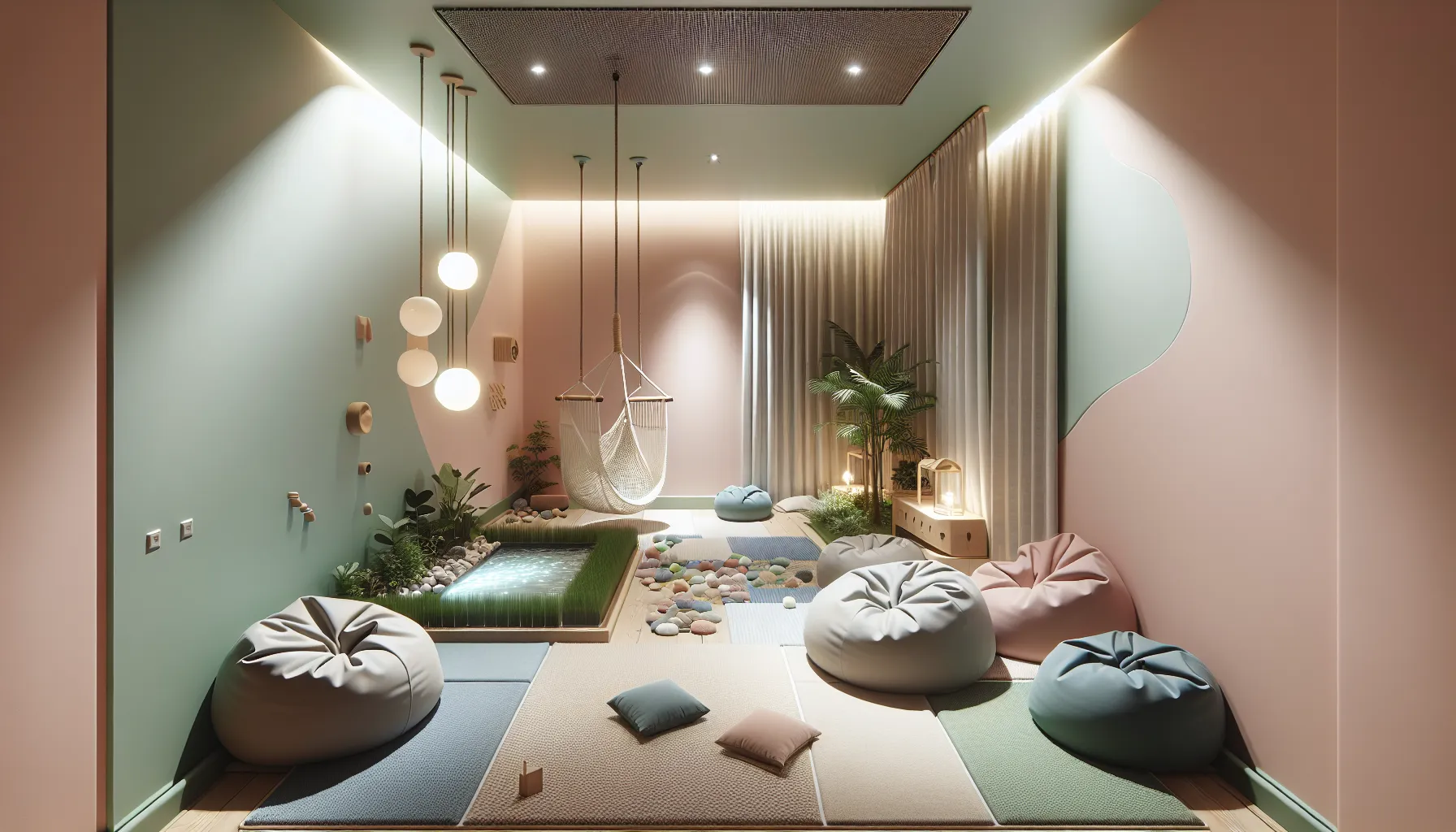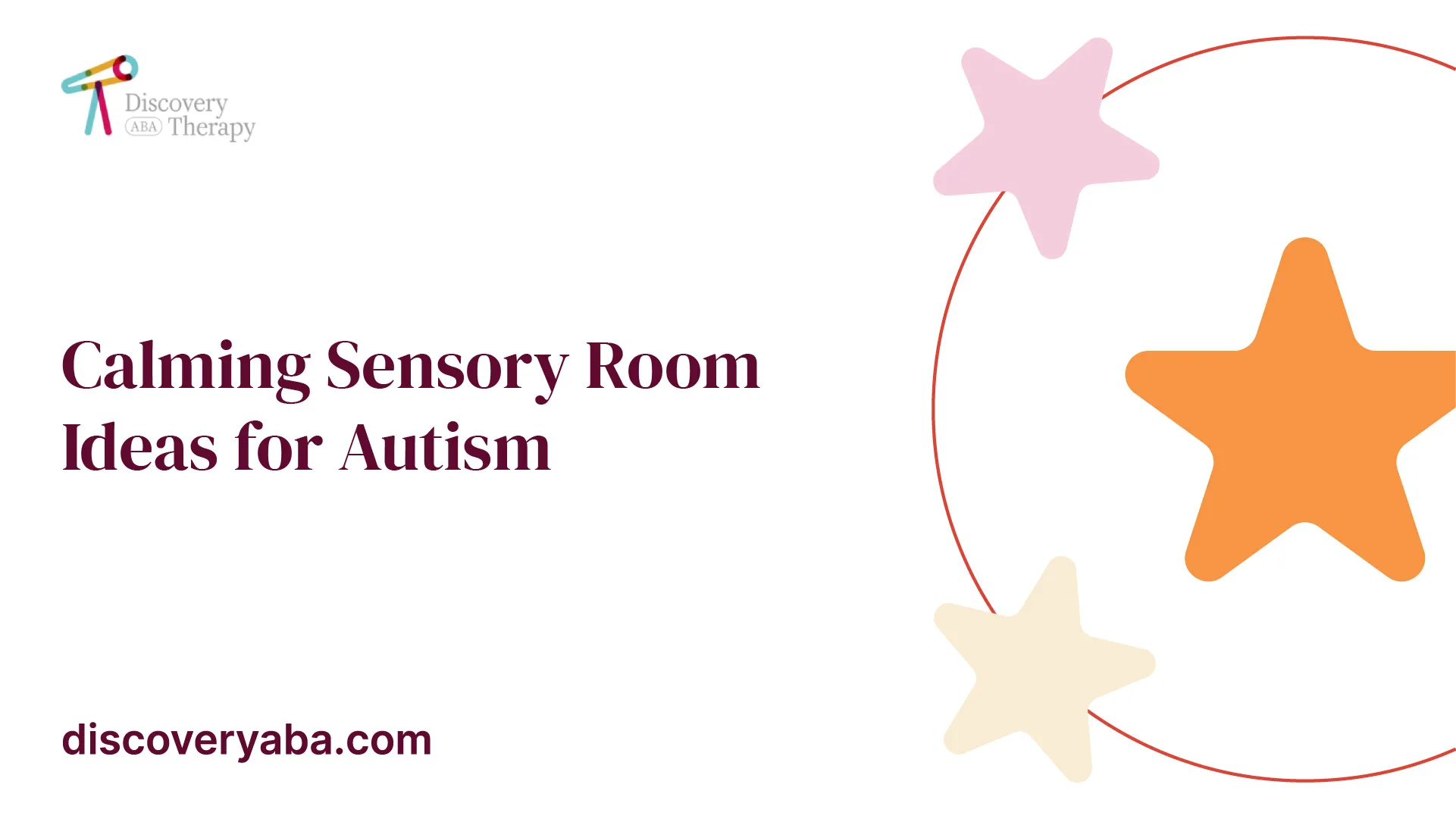Calming Sensory Room Ideas for Autism
Discover calming sensory room ideas for autism, creating a soothing environment to enhance well-being and promote relaxation.

Creating a Calming Sensory Environment
In the realm of sensory processing disorders, creating a calming sensory environment is essential for individuals with conditions such as autism. Sensory integration plays a crucial role in understanding the symptoms of autistic individuals, involving the processing of sensory information from the environment and the body. Sensory rooms, also known as multi-sensory environments (MSE), are safe spaces specifically designed to provide individuals with sensory processing disorders a place to decompress and cope with sensory experiences.
Understanding Sensory Integration
Sensory integration refers to the process by which the nervous system receives, organizes, and interprets sensory information from the environment and the body. For individuals with autism, sensory integration may be disrupted, leading to hyposensitive (underreactive) or hypersensitive (overreactive) reactions to various sensory stimuli.
Autistic individuals may have varying responses to sensory inputs such as vestibular (movement and balance), proprioceptive (body awareness), tactile (touch), auditory (sound), visual (sight), and olfactory (smell) senses. These reactions can impact their daily lives, making it challenging to cope with sensory information in their surroundings.

Importance of Sensory Rooms
Sensory rooms have gained recognition for their significant benefits in supporting individuals with sensory processing disorders, including autism. These dedicated spaces provide a calming environment where individuals can regain control of their emotions and sensory experiences.
The primary goal of sensory rooms is to offer individuals a safe and controlled space to explore and interact with sensory stimuli in a way that suits their unique needs. These rooms can be fully equipped spaces or designated areas within larger rooms, tailored to the individual's requirements. The environment within a sensory room is carefully designed to provide a range of sensory experiences that promote relaxation and self-regulation.
The benefits of sensory rooms are vast, including:
- Calming effects: Sensory rooms create a peaceful atmosphere that helps individuals reduce stress, anxiety, and overstimulation.
- Stimulation: Sensory rooms offer opportunities for sensory exploration and engagement, promoting sensory development and cognitive growth.
- Socialization: These spaces facilitate social interaction, encouraging communication, and fostering positive relationships.
- Improved focus: Sensory rooms can assist in improving attention and concentration skills.
- Sensory-motor skills development: Engaging with various sensory stimuli in the room can support the development of sensory-motor skills, coordination, and balance.
- Cognitive development: Sensory rooms provide opportunities for learning, problem-solving, and cognitive development through sensory experiences.
By incorporating sensory rooms into therapeutic and educational settings, individuals with sensory processing disorders, including autism, can learn valuable coping skills that can be applied in their daily lives outside of the sensory room. These rooms serve as an essential tool in enhancing well-being and supporting the unique sensory needs of individuals with autism.
Designing an Effective Sensory Room
To create a calming sensory environment for individuals with autism, designing an effective sensory room is essential. Sensory rooms are specially designed spaces that utilize sensory equipment to create a controlled environment focused on sensory experiences. These rooms are tailored to meet the specific needs of individuals, including children with autism, by providing a variety of sensory stimuli. The purpose of sensory rooms is to support sensory integration therapy, manage overstimulation and stress, and promote overall well-being [3].
Elements of a Sensory Room
When designing a sensory room, it is important to consider the following elements:
- Lighting: Use adjustable lighting options to create a soothing atmosphere. Dimmable lights or LED light panels with different color options can help create a calming environment.
- Sound: Incorporate sound elements such as soft music, white noise machines, or nature sounds to promote relaxation and auditory stimulation. It is important to ensure that the sound levels can be adjusted to suit individual preferences.
- Textures: Include a variety of tactile surfaces like soft cushions, textured mats, or sensory balls to provide tactile stimulation and promote sensory exploration.
- Seating and Comfort: Provide comfortable seating options like bean bags, cozy chairs, or soft floor mats, ensuring individuals can relax and feel at ease in the sensory room.
- Visual Stimulation: Create visually stimulating environments by using colorful visuals, wall decals, or interactive projectors to enhance engagement and focus.
- Safety: Prioritize safety by ensuring that the sensory room is free from hazards and that all equipment is securely installed. Soft padding on walls and floors can help prevent injuries during sensory exploration.
Implementing Sensory Toys
Sensory toys are an important component of a sensory room, as they offer a wide range of tactile, auditory, and visual experiences. These toys are designed to engage the senses and provide individuals with opportunities for exploration and self-regulation.
When choosing sensory toys, consider the specific needs and preferences of the individuals using the sensory room. Some popular sensory toys include:
- Fidget Toys: These small handheld toys, such as stress balls, sensory rings, or textured cubes, provide tactile stimulation and help individuals focus and self-soothe.
- Sensory Balls: Soft, textured, or squishy balls can be used for tactile stimulation, hand-eye coordination, and gross motor skill development.
- Visual Toys: Incorporate visual toys like light-up toys, fiber optic wands, or visual projectors to enhance visual stimulation and create a calming ambiance.
- Auditory Toys: Musical instruments, sound machines, or interactive toys that produce soothing sounds can help individuals relax and engage their auditory senses.
- Weighted Toys: Weighted blankets, lap pads, or stuffed animals provide deep pressure input, which can have a calming and grounding effect on individuals with sensory sensitivities.
By incorporating a variety of sensory toys into the sensory room, individuals with autism can explore different sensory experiences, develop self-regulation skills, and find comfort in a controlled and supportive environment.
Remember, when designing a sensory room, it is important to consider the individual needs of the users, the intended use of the room, and long-term adaptability. Proper training for staff members is also crucial to ensure the safe and effective use of the space.
Utilizing Colors in Sensory Environments
Colors play a crucial role in creating a sensory environment that promotes calmness and well-being for individuals with autism. The impact of colors on the sensory experience can vary, as autistic children have different color preferences and responses to various shades. Understanding the effects of colors and choosing appropriate calming color schemes are essential in designing an effective sensory room.
Impact of Colors on Sensory Experience
Autistic children are often more sensitive to colors and perceive them with greater intensity than others. Colors in the built environment can significantly affect their mood, learning, and behavior. When creating a calming sensory environment, it's important to consider the following effects of colors:
- Pastel Tones: Pastel shades, such as soft blues, gentle greens, and muted pinks, are comforting, calming, and supportive. These colors are beneficial for children on the autistic spectrum or those with active behavioral and impulse issues.
- Neutral Colors: Neutral tones, such as beige, cream, and light gray, create a sense of well-being. They provide a soothing backdrop and can help reduce overstimulation.
- Blue: Blue is known to encourage calmness, regulate the nervous system, and create a quiet and relaxing space. It can be particularly beneficial in sensory rooms to create a serene environment.
- Green: Green is associated with nature and has a calming effect. It creates an ideal learning environment, aids concentration and focus, and reduces overstimulation.
- Pink: Pink is often associated with safety, love, and nurturing. It can provide a sense of comfort and security for certain individuals.
Choosing Calming Color Schemes
When designing a sensory room, selecting the right color scheme is crucial to create a calming atmosphere. The choice of colors should be based on the specific needs and preferences of the individual. Consider the following guidelines when choosing a calming color scheme:
- Muted and Soft Hues: Opt for muted and soft hues of colors rather than bright and intense shades. These gentle colors help create a soothing environment.
- Individual Preferences: Take into account the individual's preferences and responses to different colors. Some individuals may find certain colors more calming or stimulating than others.
- Pastel and Neutral Combinations: Combining pastel and neutral colors can create a harmonious and calming effect. Use pastel shades as the dominant color and complement them with neutral tones.
- Consider Different Spaces: Different spaces within the sensory room can have varying color schemes based on their intended purpose. For example, more vibrant and engaging colors like yellow, orange, and purple can be used in play or activity areas to enhance energy levels and encourage socialization.
By carefully selecting and combining colors in a sensory environment, it is possible to create a calming and supportive space for individuals with autism. Remember to consider individual preferences, the effects of colors on mood and behavior, and the specific needs of the individual when designing a sensory room.
Incorporating Calming Sensory Lights
In a calming sensory room designed for individuals with autism and other sensory disorders, the use of calming sensory lights plays a crucial role. Various types of calming sensory lights can be incorporated to create a controlled sensory environment that enhances focus, attention to detail, interaction, and development for users with different sensory needs. Let's explore the types of calming sensory lights and the benefits they offer.
Types of Calming Sensory Lights
- Bubble Tubes: Bubble tubes are considered one of the most useful and calming lights for individuals with autism, ADHD, Alzheimer's, dementia, and sensory processing disorder (SPD). These cylindrical tubes filled with water and bubbles create a captivating visual display. Bubble tubes provide several benefits, including skill development in visual tracking, auditory awareness, cause and effect, and social interaction. They offer a fun and engaging sensory experience for users of all ages.
- Projectors: Projectors allow for light to be projected onto walls, floors, ceilings, and mirrors, creating stunning visual effects in a sensory room. They can improve orientation through visual stimulation, prompt discussion through themed storytelling, and add an element of movement to keep the space interesting. Projectors provide a dynamic and immersive sensory experience, making them a versatile option for enhancing the sensory environment.
- Mirror Balls: Mirror balls reflect light to create dazzling and stimulating sensory lights in a room. They offer a therapeutic multisensory experience by creating patterns of light and movement. While mirror balls can add pizzazz to a sensory room, it's important to consider individual needs, as some individuals may find the reflected light overwhelming. It's essential to personalize the sensory environment based on the preferences and sensitivities of the individual.
- Fiber Optic Lights: Fiber optic lights are tactile and visually appealing for individuals with autism and other sensory disorders. These lights come in various forms, such as strands, sprays, curtains, and carpets. Fiber optic lights provide calming sensory effects and stimulate both vision and touch. They create a soothing and immersive multisensory experience, making them an excellent addition to a sensory room.
Benefits of Calming Sensory Lights
The incorporation of calming sensory lights in a sensory room offers numerous benefits:
- Sensory Stimulation: Calming sensory lights provide gentle stimulation to the senses, helping individuals with sensory disorders engage and interact with their environment.
- Relaxation and Calmness: The soothing effects of calming lights can promote relaxation and create a sense of calmness, reducing anxiety and stress.
- Visual Tracking and Attention: Lights that move or change colors can help improve visual tracking skills and enhance attention span.
- Skill Development: Calming sensory lights, such as bubble tubes, can aid in the development of various skills, including visual tracking, auditory awareness, cause and effect understanding, and social interaction.
- Multisensory Experience: The combination of lights, colors, and visual effects provides a multisensory experience that can engage multiple senses simultaneously, promoting overall sensory integration.
By incorporating different types of calming sensory lights in a sensory room, individuals with autism and other sensory disorders can benefit from an environment that fosters relaxation, engagement, and skill development. It's important to choose the right lights based on individual preferences and sensitivities to create a personalized and effective sensory environment.
Enhancing Sensory Experience with Light
Light plays a crucial role in creating a calming sensory environment for individuals with autism, ADHD, Alzheimer's, dementia, and sensory processing disorder (SPD). Calming sensory lights are essential components of a sensory room, helping to create a controlled environment that enhances focus, attention to detail, interaction, and development for individuals with various sensory disorders.
Bubble Tubes and Their Benefits
Bubble tubes are considered one of the most useful and calming lights for individuals with autism. These tubes emit a soft glow and feature continuously rising bubbles, creating a visually captivating and calming effect. The benefits of bubble tubes in a sensory room are numerous. They aid in visual tracking, auditory awareness, cause and effect understanding, and social interaction. Additionally, bubble tubes can provide a fun and engaging sensory experience for users of all ages [6].

Projectors for Visual Stimulation
Projectors are another valuable addition to a sensory room, allowing light to be projected onto walls, floors, ceilings, and mirrors. This creates stunning visual effects that can improve orientation, prompt discussion through themed storytelling, and offer an element of movement to keep the space interesting. Projectors provide visual stimulation that can engage and captivate individuals in the sensory room.
Projectors offer a versatile range of effects and themes, allowing for customization based on individual preferences and needs. The projected visuals can help individuals with autism focus their attention, promote relaxation, and encourage interaction with their surroundings.
By incorporating bubble tubes and projectors into a sensory room, individuals with autism and other sensory disorders can benefit from a calming and engaging sensory experience. These lights provide not only visual stimulation but also opportunities for skill development, social interaction, and overall well-being. It's important to consider the specific needs and preferences of individuals when selecting and implementing these lights in a sensory environment.
Engaging with Multisensory Experiences
In a calming sensory room, engaging with multisensory experiences is essential to create a therapeutic and immersive environment for individuals with autism. Two elements that can enhance the sensory experience are mirror balls and fiber optic lights.
Mirror Balls for Stimulating Effects
Mirror balls are a popular addition to sensory rooms as they reflect light, creating dazzling and stimulating effects. These rotating balls project light patterns onto the walls and ceiling, providing a visually captivating experience. The play of light can help individuals with autism focus their attention and promote relaxation.
Mirror balls offer a dynamic sensory experience as they create a sense of movement and change in the environment. The reflected light can also contribute to a calming atmosphere by providing gentle visual stimulation. However, it's important to note that mirror balls may not suit everyone's sensory needs. It's crucial to consider individual preferences and sensitivities when incorporating them into a sensory room.
Fiber Optic Lights for Tactile Stimulation
Fiber optic lights are another fantastic option for engaging with multisensory experiences in a calming sensory room. These lights consist of strands or sprays that emit soft, colorful light. They are tactile, safe to touch, and visually appealing, making them suitable for individuals with autism and other sensory disorders.
Fiber optic lights come in various forms, including curtains, carpets, and standalone strands. The tactile nature of these lights encourages individuals to explore and interact with them, providing both visual and tactile stimulation. They can help stimulate vision and touch, promoting a multisensory experience that can be calming and soothing.
When incorporating fiber optic lights into a sensory room, consider the individual's preferences and sensitivities. Some individuals may find the gentle light and textures of fiber optic lights particularly calming, while others may prefer different types of sensory stimulation.
By incorporating mirror balls and fiber optic lights, a calming sensory room can provide engaging multisensory experiences for individuals with autism. These elements contribute to the overall ambiance of the space, creating a soothing and therapeutic environment that supports their well-being.
References
- https://www.sciencedirect.com/science/article/pii/S1110016818302072
- https://enablingdevices.com/blog/benefits-sensory-rooms-special-needs/
- https://www.abtaba.com/blog/sensory-room-ideas-for-children-with-autism/
- https://www.ncbi.nlm.nih.gov/pmc/articles/PMC9748440/
- https://www.senteq.co.uk/the-importance-of-colour-in-sensory-rooms/
- https://www.experia-usa.com/blog/calming-sensory-lights-for-your-sensory-room/
Does Your Child Have An Autism Diagnosis?
Learn More About How ABA Therapy Can Help
Find More Articles
Contact us
North Carolina, Nevada, Utah, Virginia
New Hampshire, Maine
Arizona, Colorado, Georgia, New Mexico, Oklahoma, Texas
.avif)




































































































